MGT601 - Dynamic Leadership: A Comprehensive Leadership Plan Report
VerifiedAdded on 2022/09/22
|16
|3679
|25
Report
AI Summary
This report outlines a self-development process through critical reflection on leadership theories to create personal leadership strategies. It incorporates feedback from family, the Johari Window model, and the Global Emotional Intelligence Test (GEIT) to understand personality traits and emotional intelligence. The report identifies personal strengths and weaknesses, utilizes the GROW model for personality growth, and discusses the importance of aligning capabilities with leadership roles. It covers trait theory, behavioral theory, contingency theories, transactional and transformational leadership theories. The plan includes goal setting, communication style adjustments, and emotional intelligence improvements to address personality weaknesses, aiming for career advancement and effective leadership in a manufacturing setting.
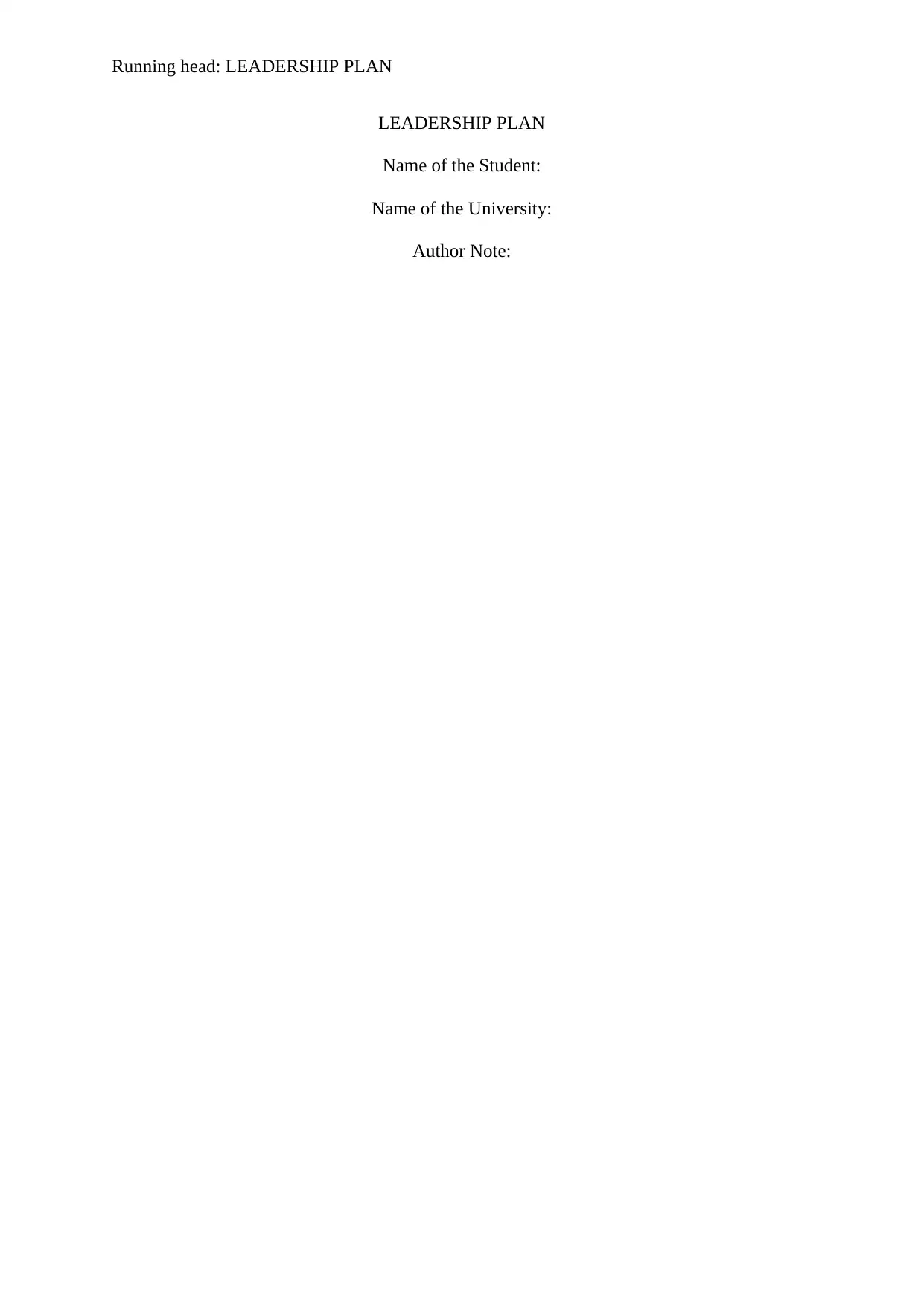
Running head: LEADERSHIP PLAN
LEADERSHIP PLAN
Name of the Student:
Name of the University:
Author Note:
LEADERSHIP PLAN
Name of the Student:
Name of the University:
Author Note:
Paraphrase This Document
Need a fresh take? Get an instant paraphrase of this document with our AI Paraphraser

1LEADERSHIP PLAN
Table of Contents
Introduction:...............................................................................................................................1
Discussion:.................................................................................................................................1
GROW model:...........................................................................................................................3
Personal strengths and weaknesses:...........................................................................................4
Goals:.........................................................................................................................................6
Plan:............................................................................................................................................7
Needed resources:......................................................................................................................9
Conclusion:..............................................................................................................................10
References:...............................................................................................................................11
Appendices:..............................................................................................................................12
Table of Contents
Introduction:...............................................................................................................................1
Discussion:.................................................................................................................................1
GROW model:...........................................................................................................................3
Personal strengths and weaknesses:...........................................................................................4
Goals:.........................................................................................................................................6
Plan:............................................................................................................................................7
Needed resources:......................................................................................................................9
Conclusion:..............................................................................................................................10
References:...............................................................................................................................11
Appendices:..............................................................................................................................12
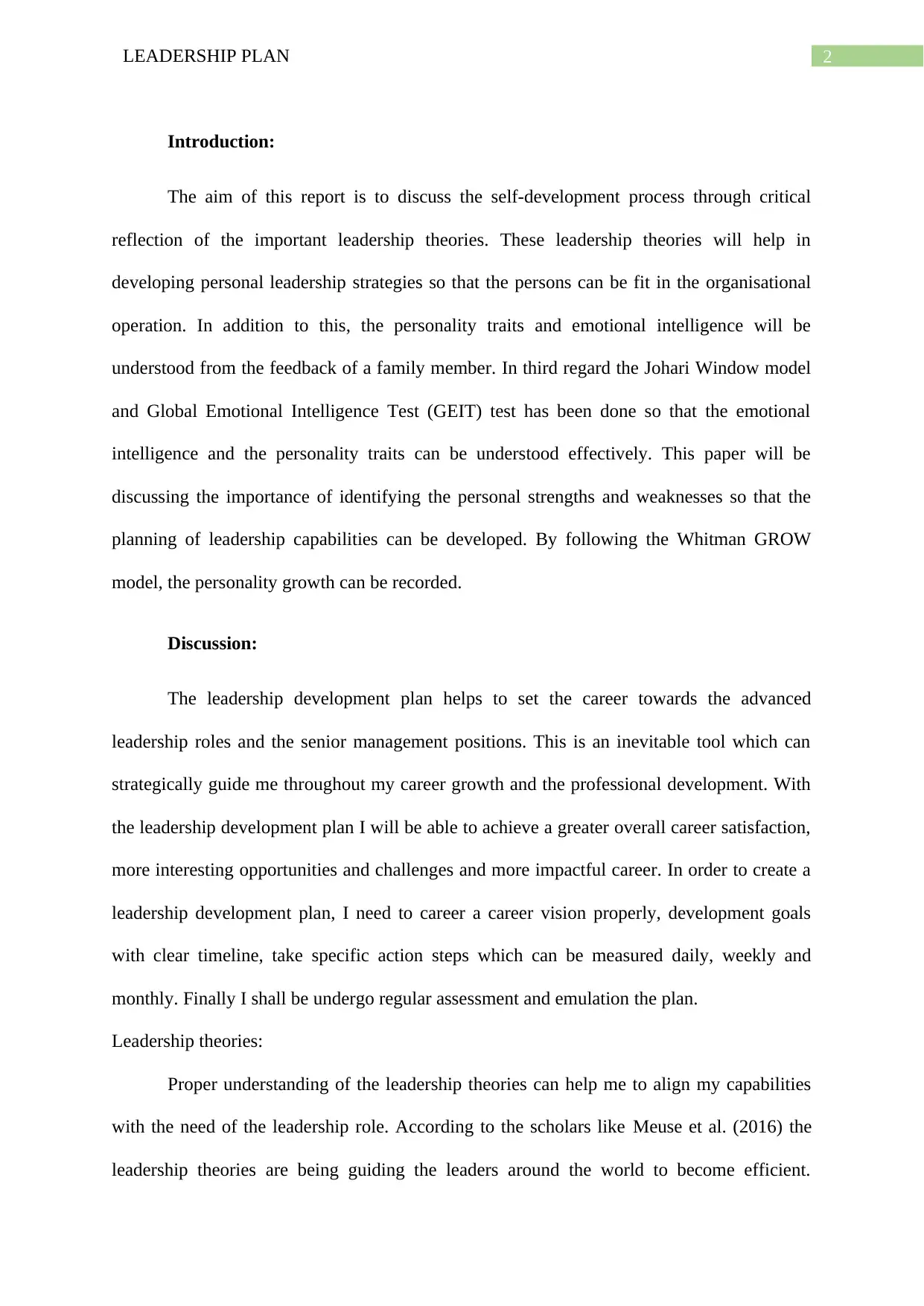
2LEADERSHIP PLAN
Introduction:
The aim of this report is to discuss the self-development process through critical
reflection of the important leadership theories. These leadership theories will help in
developing personal leadership strategies so that the persons can be fit in the organisational
operation. In addition to this, the personality traits and emotional intelligence will be
understood from the feedback of a family member. In third regard the Johari Window model
and Global Emotional Intelligence Test (GEIT) test has been done so that the emotional
intelligence and the personality traits can be understood effectively. This paper will be
discussing the importance of identifying the personal strengths and weaknesses so that the
planning of leadership capabilities can be developed. By following the Whitman GROW
model, the personality growth can be recorded.
Discussion:
The leadership development plan helps to set the career towards the advanced
leadership roles and the senior management positions. This is an inevitable tool which can
strategically guide me throughout my career growth and the professional development. With
the leadership development plan I will be able to achieve a greater overall career satisfaction,
more interesting opportunities and challenges and more impactful career. In order to create a
leadership development plan, I need to career a career vision properly, development goals
with clear timeline, take specific action steps which can be measured daily, weekly and
monthly. Finally I shall be undergo regular assessment and emulation the plan.
Leadership theories:
Proper understanding of the leadership theories can help me to align my capabilities
with the need of the leadership role. According to the scholars like Meuse et al. (2016) the
leadership theories are being guiding the leaders around the world to become efficient.
Introduction:
The aim of this report is to discuss the self-development process through critical
reflection of the important leadership theories. These leadership theories will help in
developing personal leadership strategies so that the persons can be fit in the organisational
operation. In addition to this, the personality traits and emotional intelligence will be
understood from the feedback of a family member. In third regard the Johari Window model
and Global Emotional Intelligence Test (GEIT) test has been done so that the emotional
intelligence and the personality traits can be understood effectively. This paper will be
discussing the importance of identifying the personal strengths and weaknesses so that the
planning of leadership capabilities can be developed. By following the Whitman GROW
model, the personality growth can be recorded.
Discussion:
The leadership development plan helps to set the career towards the advanced
leadership roles and the senior management positions. This is an inevitable tool which can
strategically guide me throughout my career growth and the professional development. With
the leadership development plan I will be able to achieve a greater overall career satisfaction,
more interesting opportunities and challenges and more impactful career. In order to create a
leadership development plan, I need to career a career vision properly, development goals
with clear timeline, take specific action steps which can be measured daily, weekly and
monthly. Finally I shall be undergo regular assessment and emulation the plan.
Leadership theories:
Proper understanding of the leadership theories can help me to align my capabilities
with the need of the leadership role. According to the scholars like Meuse et al. (2016) the
leadership theories are being guiding the leaders around the world to become efficient.
⊘ This is a preview!⊘
Do you want full access?
Subscribe today to unlock all pages.

Trusted by 1+ million students worldwide
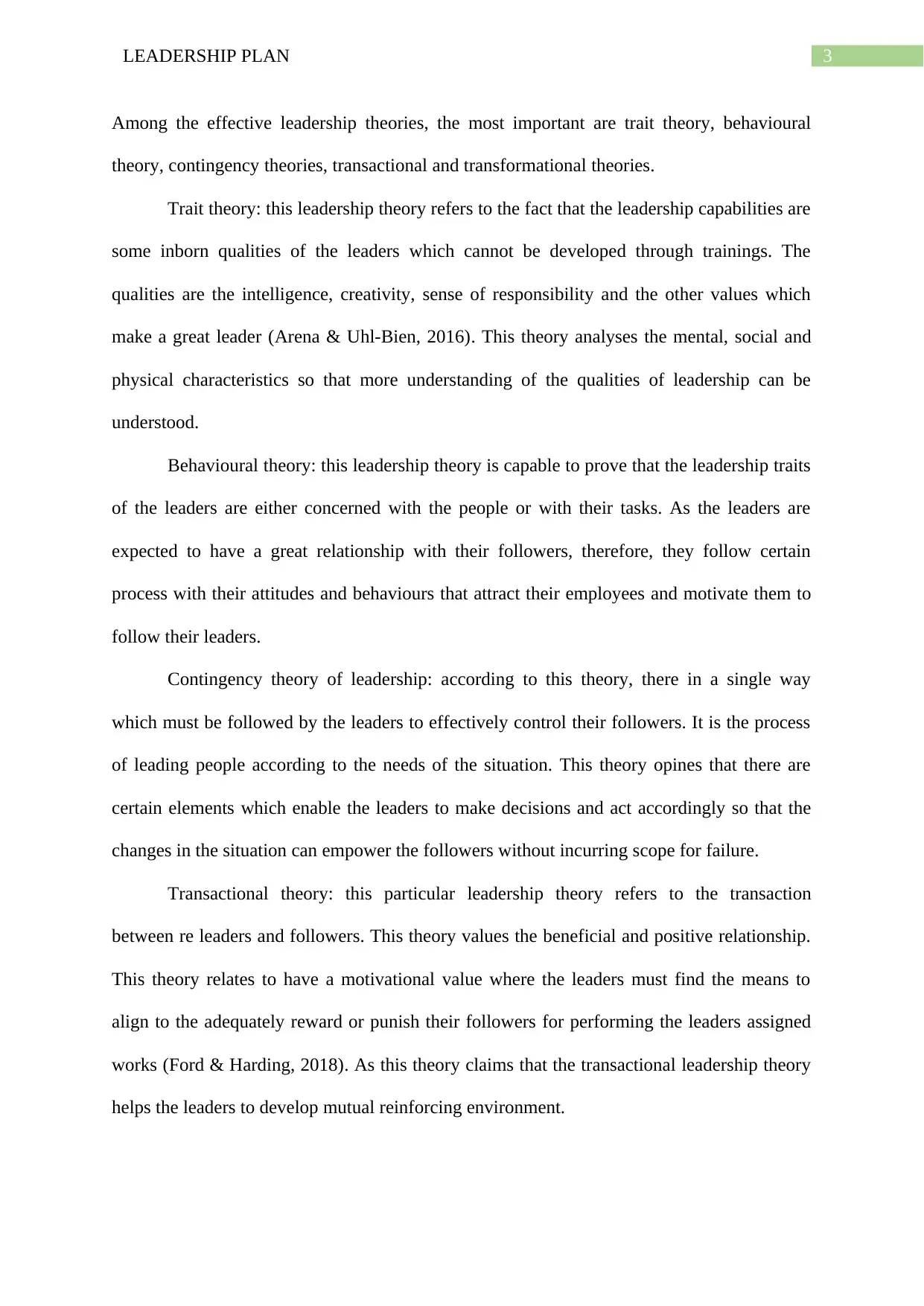
3LEADERSHIP PLAN
Among the effective leadership theories, the most important are trait theory, behavioural
theory, contingency theories, transactional and transformational theories.
Trait theory: this leadership theory refers to the fact that the leadership capabilities are
some inborn qualities of the leaders which cannot be developed through trainings. The
qualities are the intelligence, creativity, sense of responsibility and the other values which
make a great leader (Arena & Uhl-Bien, 2016). This theory analyses the mental, social and
physical characteristics so that more understanding of the qualities of leadership can be
understood.
Behavioural theory: this leadership theory is capable to prove that the leadership traits
of the leaders are either concerned with the people or with their tasks. As the leaders are
expected to have a great relationship with their followers, therefore, they follow certain
process with their attitudes and behaviours that attract their employees and motivate them to
follow their leaders.
Contingency theory of leadership: according to this theory, there in a single way
which must be followed by the leaders to effectively control their followers. It is the process
of leading people according to the needs of the situation. This theory opines that there are
certain elements which enable the leaders to make decisions and act accordingly so that the
changes in the situation can empower the followers without incurring scope for failure.
Transactional theory: this particular leadership theory refers to the transaction
between re leaders and followers. This theory values the beneficial and positive relationship.
This theory relates to have a motivational value where the leaders must find the means to
align to the adequately reward or punish their followers for performing the leaders assigned
works (Ford & Harding, 2018). As this theory claims that the transactional leadership theory
helps the leaders to develop mutual reinforcing environment.
Among the effective leadership theories, the most important are trait theory, behavioural
theory, contingency theories, transactional and transformational theories.
Trait theory: this leadership theory refers to the fact that the leadership capabilities are
some inborn qualities of the leaders which cannot be developed through trainings. The
qualities are the intelligence, creativity, sense of responsibility and the other values which
make a great leader (Arena & Uhl-Bien, 2016). This theory analyses the mental, social and
physical characteristics so that more understanding of the qualities of leadership can be
understood.
Behavioural theory: this leadership theory is capable to prove that the leadership traits
of the leaders are either concerned with the people or with their tasks. As the leaders are
expected to have a great relationship with their followers, therefore, they follow certain
process with their attitudes and behaviours that attract their employees and motivate them to
follow their leaders.
Contingency theory of leadership: according to this theory, there in a single way
which must be followed by the leaders to effectively control their followers. It is the process
of leading people according to the needs of the situation. This theory opines that there are
certain elements which enable the leaders to make decisions and act accordingly so that the
changes in the situation can empower the followers without incurring scope for failure.
Transactional theory: this particular leadership theory refers to the transaction
between re leaders and followers. This theory values the beneficial and positive relationship.
This theory relates to have a motivational value where the leaders must find the means to
align to the adequately reward or punish their followers for performing the leaders assigned
works (Ford & Harding, 2018). As this theory claims that the transactional leadership theory
helps the leaders to develop mutual reinforcing environment.
Paraphrase This Document
Need a fresh take? Get an instant paraphrase of this document with our AI Paraphraser
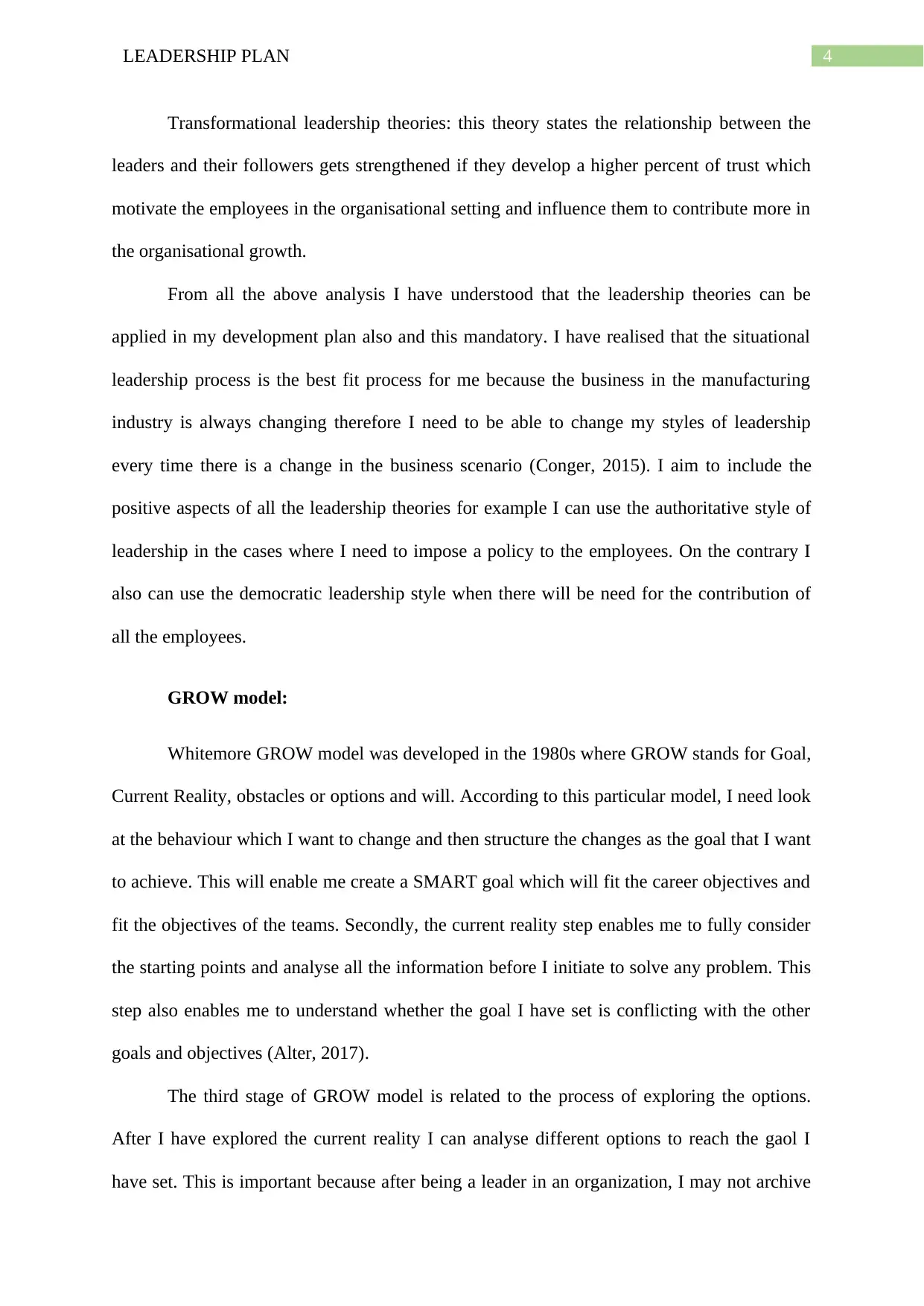
4LEADERSHIP PLAN
Transformational leadership theories: this theory states the relationship between the
leaders and their followers gets strengthened if they develop a higher percent of trust which
motivate the employees in the organisational setting and influence them to contribute more in
the organisational growth.
From all the above analysis I have understood that the leadership theories can be
applied in my development plan also and this mandatory. I have realised that the situational
leadership process is the best fit process for me because the business in the manufacturing
industry is always changing therefore I need to be able to change my styles of leadership
every time there is a change in the business scenario (Conger, 2015). I aim to include the
positive aspects of all the leadership theories for example I can use the authoritative style of
leadership in the cases where I need to impose a policy to the employees. On the contrary I
also can use the democratic leadership style when there will be need for the contribution of
all the employees.
GROW model:
Whitemore GROW model was developed in the 1980s where GROW stands for Goal,
Current Reality, obstacles or options and will. According to this particular model, I need look
at the behaviour which I want to change and then structure the changes as the goal that I want
to achieve. This will enable me create a SMART goal which will fit the career objectives and
fit the objectives of the teams. Secondly, the current reality step enables me to fully consider
the starting points and analyse all the information before I initiate to solve any problem. This
step also enables me to understand whether the goal I have set is conflicting with the other
goals and objectives (Alter, 2017).
The third stage of GROW model is related to the process of exploring the options.
After I have explored the current reality I can analyse different options to reach the gaol I
have set. This is important because after being a leader in an organization, I may not archive
Transformational leadership theories: this theory states the relationship between the
leaders and their followers gets strengthened if they develop a higher percent of trust which
motivate the employees in the organisational setting and influence them to contribute more in
the organisational growth.
From all the above analysis I have understood that the leadership theories can be
applied in my development plan also and this mandatory. I have realised that the situational
leadership process is the best fit process for me because the business in the manufacturing
industry is always changing therefore I need to be able to change my styles of leadership
every time there is a change in the business scenario (Conger, 2015). I aim to include the
positive aspects of all the leadership theories for example I can use the authoritative style of
leadership in the cases where I need to impose a policy to the employees. On the contrary I
also can use the democratic leadership style when there will be need for the contribution of
all the employees.
GROW model:
Whitemore GROW model was developed in the 1980s where GROW stands for Goal,
Current Reality, obstacles or options and will. According to this particular model, I need look
at the behaviour which I want to change and then structure the changes as the goal that I want
to achieve. This will enable me create a SMART goal which will fit the career objectives and
fit the objectives of the teams. Secondly, the current reality step enables me to fully consider
the starting points and analyse all the information before I initiate to solve any problem. This
step also enables me to understand whether the goal I have set is conflicting with the other
goals and objectives (Alter, 2017).
The third stage of GROW model is related to the process of exploring the options.
After I have explored the current reality I can analyse different options to reach the gaol I
have set. This is important because after being a leader in an organization, I may not archive
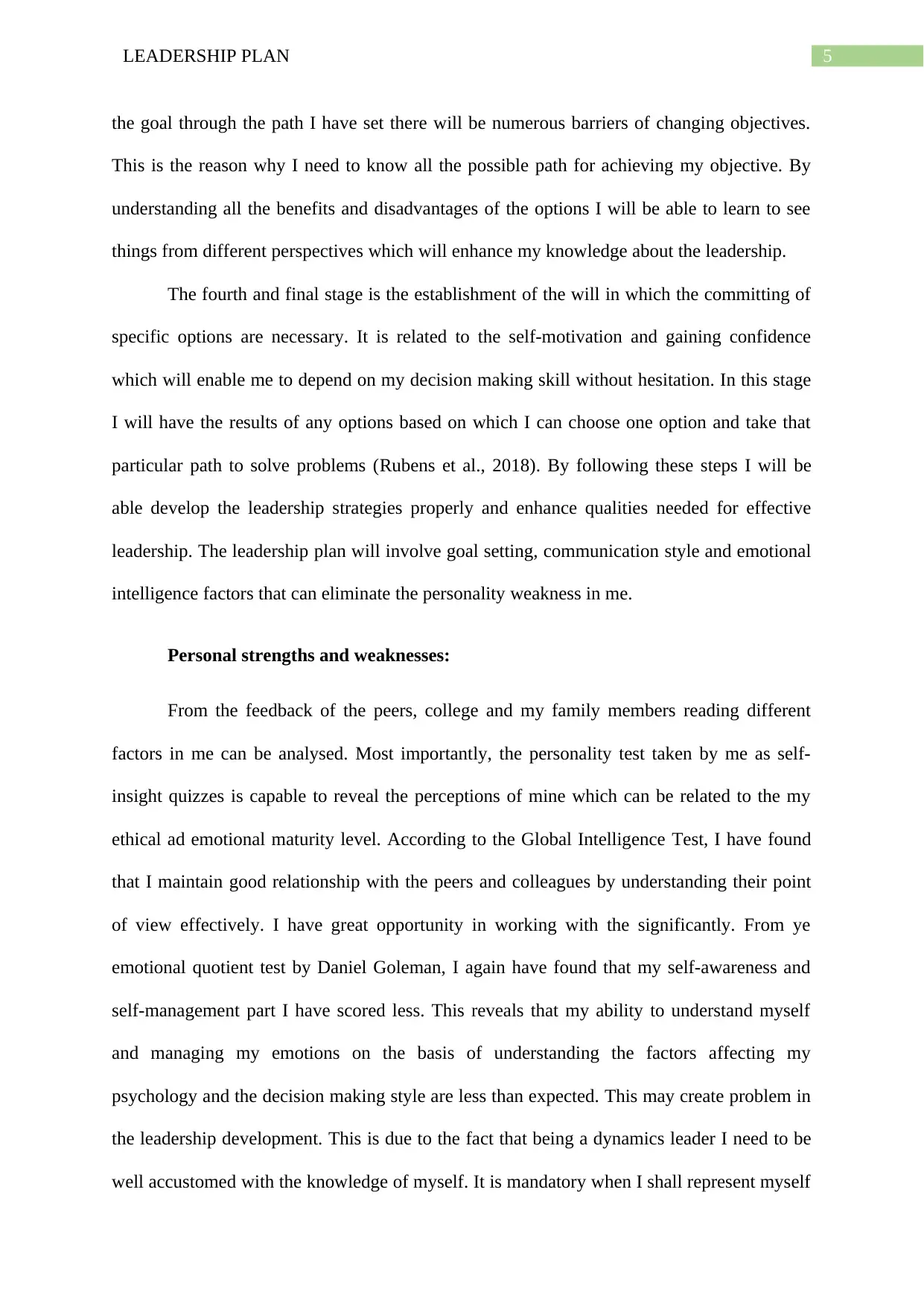
5LEADERSHIP PLAN
the goal through the path I have set there will be numerous barriers of changing objectives.
This is the reason why I need to know all the possible path for achieving my objective. By
understanding all the benefits and disadvantages of the options I will be able to learn to see
things from different perspectives which will enhance my knowledge about the leadership.
The fourth and final stage is the establishment of the will in which the committing of
specific options are necessary. It is related to the self-motivation and gaining confidence
which will enable me to depend on my decision making skill without hesitation. In this stage
I will have the results of any options based on which I can choose one option and take that
particular path to solve problems (Rubens et al., 2018). By following these steps I will be
able develop the leadership strategies properly and enhance qualities needed for effective
leadership. The leadership plan will involve goal setting, communication style and emotional
intelligence factors that can eliminate the personality weakness in me.
Personal strengths and weaknesses:
From the feedback of the peers, college and my family members reading different
factors in me can be analysed. Most importantly, the personality test taken by me as self-
insight quizzes is capable to reveal the perceptions of mine which can be related to the my
ethical ad emotional maturity level. According to the Global Intelligence Test, I have found
that I maintain good relationship with the peers and colleagues by understanding their point
of view effectively. I have great opportunity in working with the significantly. From ye
emotional quotient test by Daniel Goleman, I again have found that my self-awareness and
self-management part I have scored less. This reveals that my ability to understand myself
and managing my emotions on the basis of understanding the factors affecting my
psychology and the decision making style are less than expected. This may create problem in
the leadership development. This is due to the fact that being a dynamics leader I need to be
well accustomed with the knowledge of myself. It is mandatory when I shall represent myself
the goal through the path I have set there will be numerous barriers of changing objectives.
This is the reason why I need to know all the possible path for achieving my objective. By
understanding all the benefits and disadvantages of the options I will be able to learn to see
things from different perspectives which will enhance my knowledge about the leadership.
The fourth and final stage is the establishment of the will in which the committing of
specific options are necessary. It is related to the self-motivation and gaining confidence
which will enable me to depend on my decision making skill without hesitation. In this stage
I will have the results of any options based on which I can choose one option and take that
particular path to solve problems (Rubens et al., 2018). By following these steps I will be
able develop the leadership strategies properly and enhance qualities needed for effective
leadership. The leadership plan will involve goal setting, communication style and emotional
intelligence factors that can eliminate the personality weakness in me.
Personal strengths and weaknesses:
From the feedback of the peers, college and my family members reading different
factors in me can be analysed. Most importantly, the personality test taken by me as self-
insight quizzes is capable to reveal the perceptions of mine which can be related to the my
ethical ad emotional maturity level. According to the Global Intelligence Test, I have found
that I maintain good relationship with the peers and colleagues by understanding their point
of view effectively. I have great opportunity in working with the significantly. From ye
emotional quotient test by Daniel Goleman, I again have found that my self-awareness and
self-management part I have scored less. This reveals that my ability to understand myself
and managing my emotions on the basis of understanding the factors affecting my
psychology and the decision making style are less than expected. This may create problem in
the leadership development. This is due to the fact that being a dynamics leader I need to be
well accustomed with the knowledge of myself. It is mandatory when I shall represent myself
⊘ This is a preview!⊘
Do you want full access?
Subscribe today to unlock all pages.

Trusted by 1+ million students worldwide
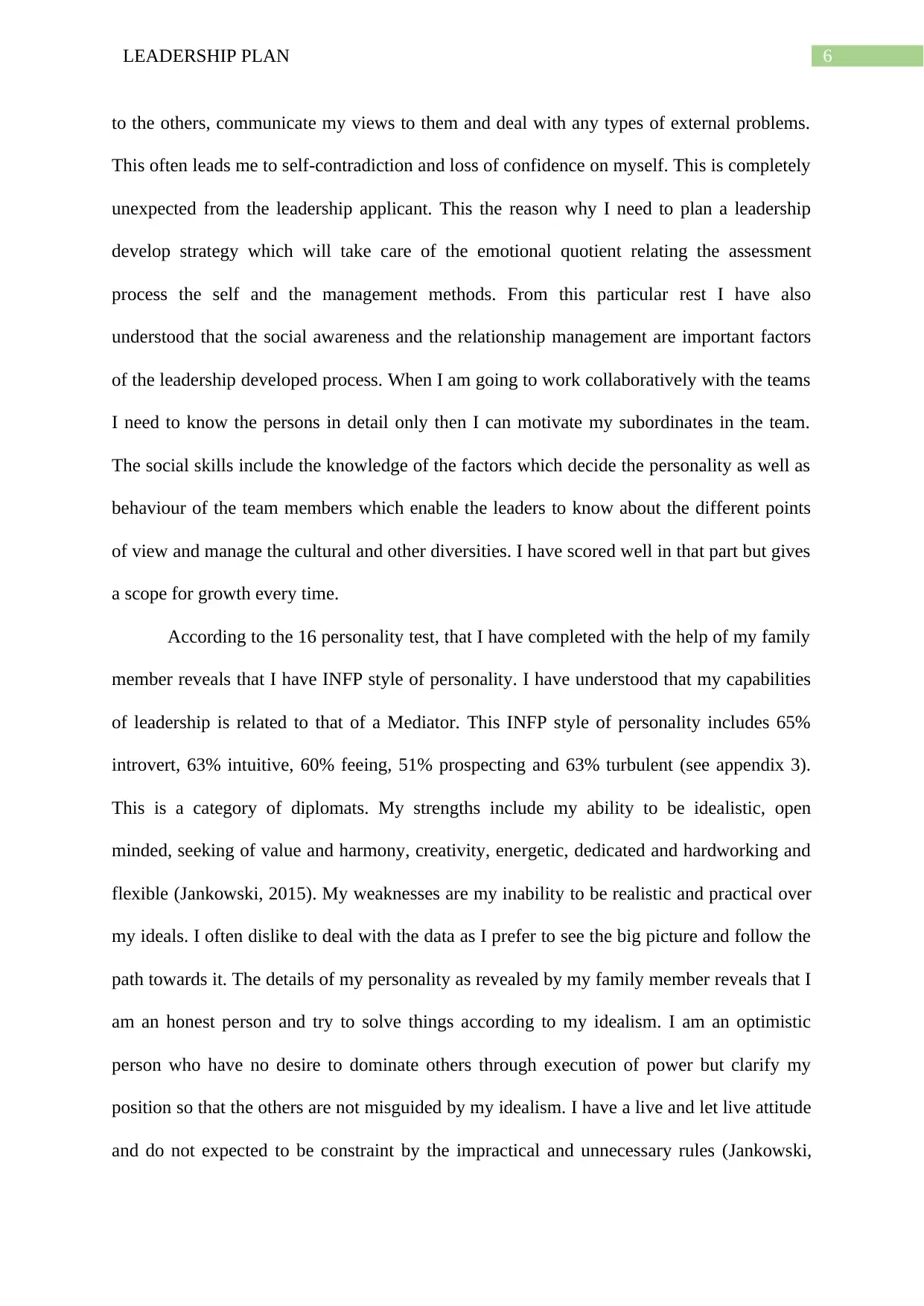
6LEADERSHIP PLAN
to the others, communicate my views to them and deal with any types of external problems.
This often leads me to self-contradiction and loss of confidence on myself. This is completely
unexpected from the leadership applicant. This the reason why I need to plan a leadership
develop strategy which will take care of the emotional quotient relating the assessment
process the self and the management methods. From this particular rest I have also
understood that the social awareness and the relationship management are important factors
of the leadership developed process. When I am going to work collaboratively with the teams
I need to know the persons in detail only then I can motivate my subordinates in the team.
The social skills include the knowledge of the factors which decide the personality as well as
behaviour of the team members which enable the leaders to know about the different points
of view and manage the cultural and other diversities. I have scored well in that part but gives
a scope for growth every time.
According to the 16 personality test, that I have completed with the help of my family
member reveals that I have INFP style of personality. I have understood that my capabilities
of leadership is related to that of a Mediator. This INFP style of personality includes 65%
introvert, 63% intuitive, 60% feeing, 51% prospecting and 63% turbulent (see appendix 3).
This is a category of diplomats. My strengths include my ability to be idealistic, open
minded, seeking of value and harmony, creativity, energetic, dedicated and hardworking and
flexible (Jankowski, 2015). My weaknesses are my inability to be realistic and practical over
my ideals. I often dislike to deal with the data as I prefer to see the big picture and follow the
path towards it. The details of my personality as revealed by my family member reveals that I
am an honest person and try to solve things according to my idealism. I am an optimistic
person who have no desire to dominate others through execution of power but clarify my
position so that the others are not misguided by my idealism. I have a live and let live attitude
and do not expected to be constraint by the impractical and unnecessary rules (Jankowski,
to the others, communicate my views to them and deal with any types of external problems.
This often leads me to self-contradiction and loss of confidence on myself. This is completely
unexpected from the leadership applicant. This the reason why I need to plan a leadership
develop strategy which will take care of the emotional quotient relating the assessment
process the self and the management methods. From this particular rest I have also
understood that the social awareness and the relationship management are important factors
of the leadership developed process. When I am going to work collaboratively with the teams
I need to know the persons in detail only then I can motivate my subordinates in the team.
The social skills include the knowledge of the factors which decide the personality as well as
behaviour of the team members which enable the leaders to know about the different points
of view and manage the cultural and other diversities. I have scored well in that part but gives
a scope for growth every time.
According to the 16 personality test, that I have completed with the help of my family
member reveals that I have INFP style of personality. I have understood that my capabilities
of leadership is related to that of a Mediator. This INFP style of personality includes 65%
introvert, 63% intuitive, 60% feeing, 51% prospecting and 63% turbulent (see appendix 3).
This is a category of diplomats. My strengths include my ability to be idealistic, open
minded, seeking of value and harmony, creativity, energetic, dedicated and hardworking and
flexible (Jankowski, 2015). My weaknesses are my inability to be realistic and practical over
my ideals. I often dislike to deal with the data as I prefer to see the big picture and follow the
path towards it. The details of my personality as revealed by my family member reveals that I
am an honest person and try to solve things according to my idealism. I am an optimistic
person who have no desire to dominate others through execution of power but clarify my
position so that the others are not misguided by my idealism. I have a live and let live attitude
and do not expected to be constraint by the impractical and unnecessary rules (Jankowski,
Paraphrase This Document
Need a fresh take? Get an instant paraphrase of this document with our AI Paraphraser
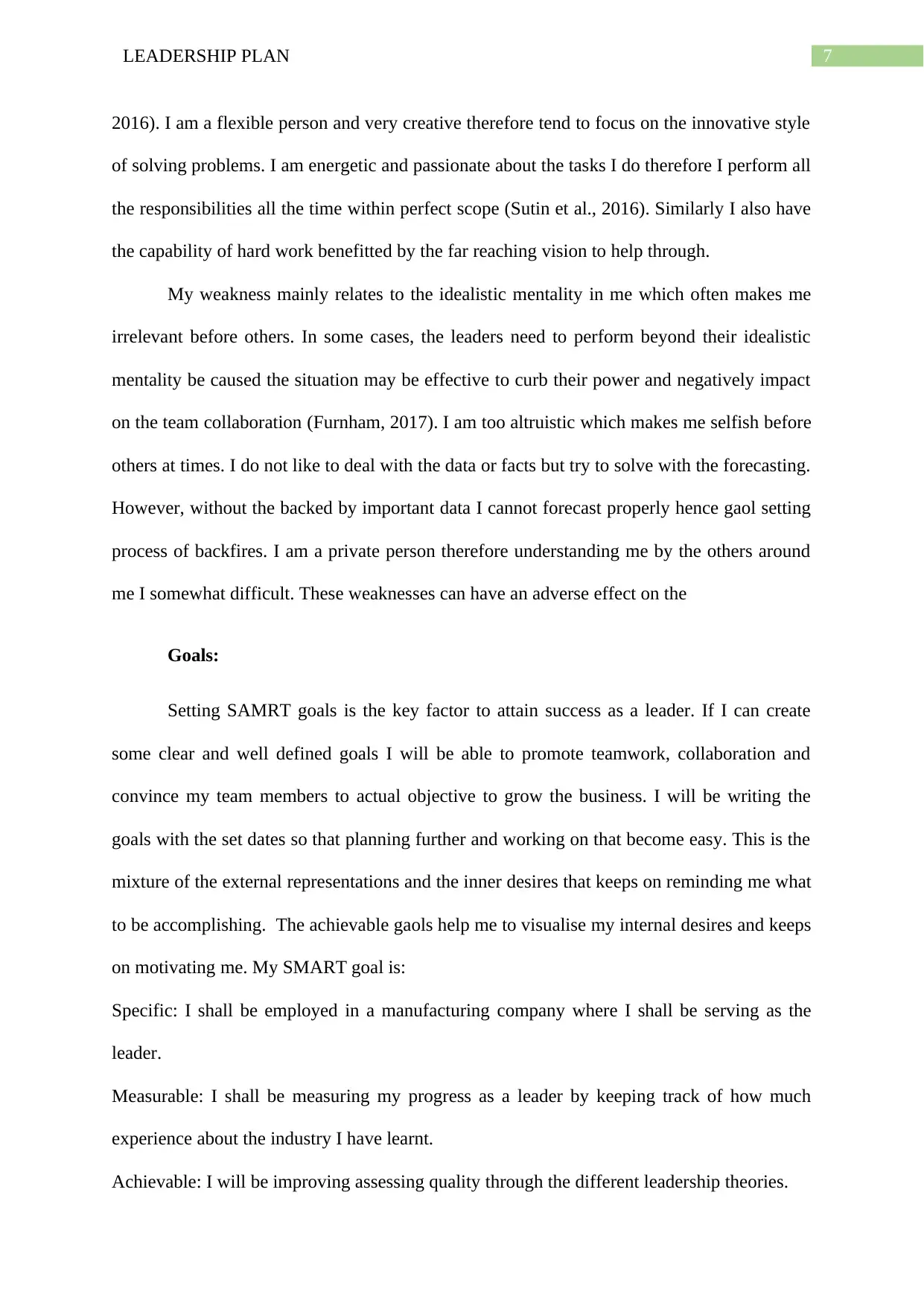
7LEADERSHIP PLAN
2016). I am a flexible person and very creative therefore tend to focus on the innovative style
of solving problems. I am energetic and passionate about the tasks I do therefore I perform all
the responsibilities all the time within perfect scope (Sutin et al., 2016). Similarly I also have
the capability of hard work benefitted by the far reaching vision to help through.
My weakness mainly relates to the idealistic mentality in me which often makes me
irrelevant before others. In some cases, the leaders need to perform beyond their idealistic
mentality be caused the situation may be effective to curb their power and negatively impact
on the team collaboration (Furnham, 2017). I am too altruistic which makes me selfish before
others at times. I do not like to deal with the data or facts but try to solve with the forecasting.
However, without the backed by important data I cannot forecast properly hence gaol setting
process of backfires. I am a private person therefore understanding me by the others around
me I somewhat difficult. These weaknesses can have an adverse effect on the
Goals:
Setting SAMRT goals is the key factor to attain success as a leader. If I can create
some clear and well defined goals I will be able to promote teamwork, collaboration and
convince my team members to actual objective to grow the business. I will be writing the
goals with the set dates so that planning further and working on that become easy. This is the
mixture of the external representations and the inner desires that keeps on reminding me what
to be accomplishing. The achievable gaols help me to visualise my internal desires and keeps
on motivating me. My SMART goal is:
Specific: I shall be employed in a manufacturing company where I shall be serving as the
leader.
Measurable: I shall be measuring my progress as a leader by keeping track of how much
experience about the industry I have learnt.
Achievable: I will be improving assessing quality through the different leadership theories.
2016). I am a flexible person and very creative therefore tend to focus on the innovative style
of solving problems. I am energetic and passionate about the tasks I do therefore I perform all
the responsibilities all the time within perfect scope (Sutin et al., 2016). Similarly I also have
the capability of hard work benefitted by the far reaching vision to help through.
My weakness mainly relates to the idealistic mentality in me which often makes me
irrelevant before others. In some cases, the leaders need to perform beyond their idealistic
mentality be caused the situation may be effective to curb their power and negatively impact
on the team collaboration (Furnham, 2017). I am too altruistic which makes me selfish before
others at times. I do not like to deal with the data or facts but try to solve with the forecasting.
However, without the backed by important data I cannot forecast properly hence gaol setting
process of backfires. I am a private person therefore understanding me by the others around
me I somewhat difficult. These weaknesses can have an adverse effect on the
Goals:
Setting SAMRT goals is the key factor to attain success as a leader. If I can create
some clear and well defined goals I will be able to promote teamwork, collaboration and
convince my team members to actual objective to grow the business. I will be writing the
goals with the set dates so that planning further and working on that become easy. This is the
mixture of the external representations and the inner desires that keeps on reminding me what
to be accomplishing. The achievable gaols help me to visualise my internal desires and keeps
on motivating me. My SMART goal is:
Specific: I shall be employed in a manufacturing company where I shall be serving as the
leader.
Measurable: I shall be measuring my progress as a leader by keeping track of how much
experience about the industry I have learnt.
Achievable: I will be improving assessing quality through the different leadership theories.
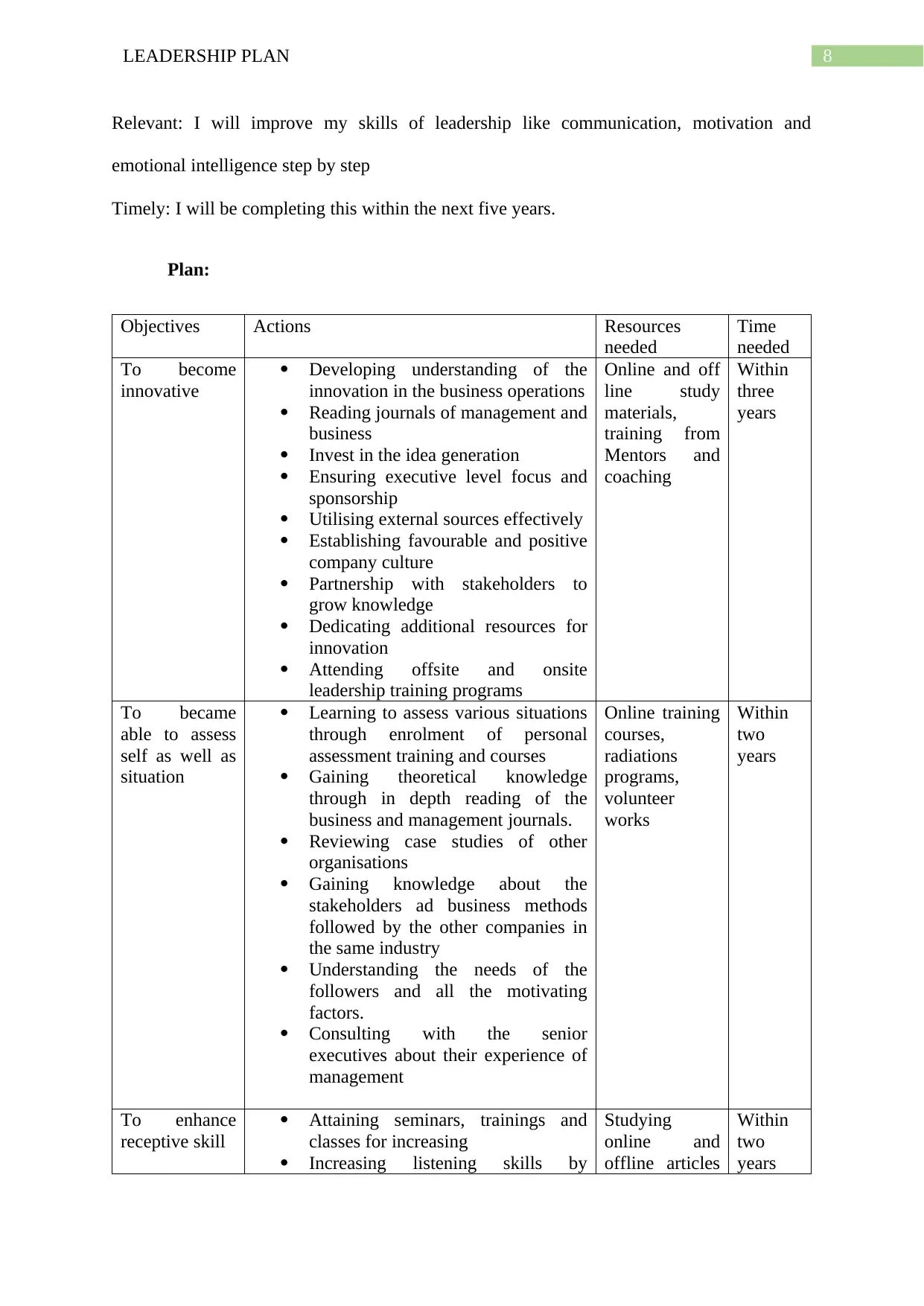
8LEADERSHIP PLAN
Relevant: I will improve my skills of leadership like communication, motivation and
emotional intelligence step by step
Timely: I will be completing this within the next five years.
Plan:
Objectives Actions Resources
needed
Time
needed
To become
innovative
Developing understanding of the
innovation in the business operations
Reading journals of management and
business
Invest in the idea generation
Ensuring executive level focus and
sponsorship
Utilising external sources effectively
Establishing favourable and positive
company culture
Partnership with stakeholders to
grow knowledge
Dedicating additional resources for
innovation
Attending offsite and onsite
leadership training programs
Online and off
line study
materials,
training from
Mentors and
coaching
Within
three
years
To became
able to assess
self as well as
situation
Learning to assess various situations
through enrolment of personal
assessment training and courses
Gaining theoretical knowledge
through in depth reading of the
business and management journals.
Reviewing case studies of other
organisations
Gaining knowledge about the
stakeholders ad business methods
followed by the other companies in
the same industry
Understanding the needs of the
followers and all the motivating
factors.
Consulting with the senior
executives about their experience of
management
Online training
courses,
radiations
programs,
volunteer
works
Within
two
years
To enhance
receptive skill
Attaining seminars, trainings and
classes for increasing
Increasing listening skills by
Studying
online and
offline articles
Within
two
years
Relevant: I will improve my skills of leadership like communication, motivation and
emotional intelligence step by step
Timely: I will be completing this within the next five years.
Plan:
Objectives Actions Resources
needed
Time
needed
To become
innovative
Developing understanding of the
innovation in the business operations
Reading journals of management and
business
Invest in the idea generation
Ensuring executive level focus and
sponsorship
Utilising external sources effectively
Establishing favourable and positive
company culture
Partnership with stakeholders to
grow knowledge
Dedicating additional resources for
innovation
Attending offsite and onsite
leadership training programs
Online and off
line study
materials,
training from
Mentors and
coaching
Within
three
years
To became
able to assess
self as well as
situation
Learning to assess various situations
through enrolment of personal
assessment training and courses
Gaining theoretical knowledge
through in depth reading of the
business and management journals.
Reviewing case studies of other
organisations
Gaining knowledge about the
stakeholders ad business methods
followed by the other companies in
the same industry
Understanding the needs of the
followers and all the motivating
factors.
Consulting with the senior
executives about their experience of
management
Online training
courses,
radiations
programs,
volunteer
works
Within
two
years
To enhance
receptive skill
Attaining seminars, trainings and
classes for increasing
Increasing listening skills by
Studying
online and
offline articles
Within
two
years
⊘ This is a preview!⊘
Do you want full access?
Subscribe today to unlock all pages.

Trusted by 1+ million students worldwide
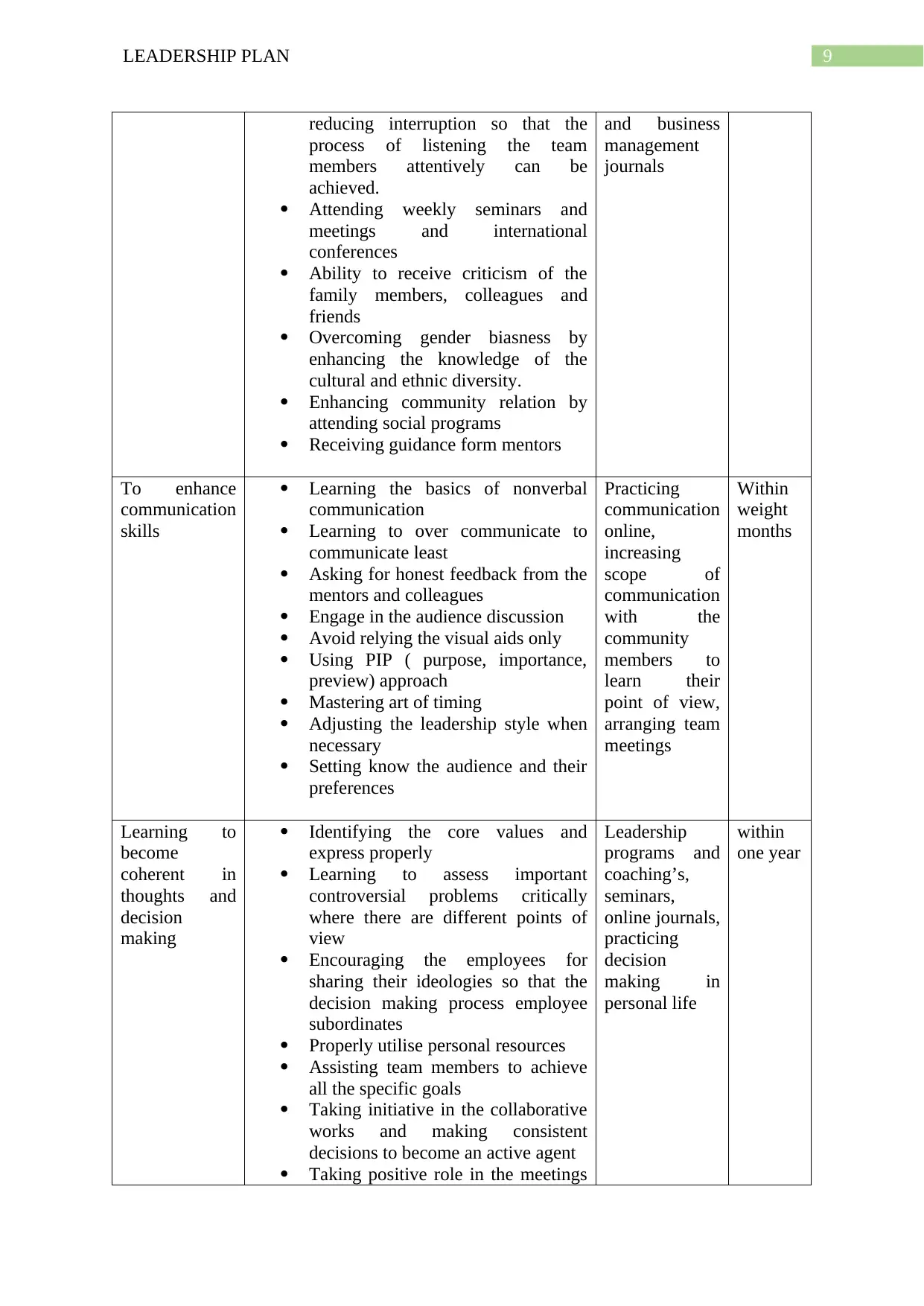
9LEADERSHIP PLAN
reducing interruption so that the
process of listening the team
members attentively can be
achieved.
Attending weekly seminars and
meetings and international
conferences
Ability to receive criticism of the
family members, colleagues and
friends
Overcoming gender biasness by
enhancing the knowledge of the
cultural and ethnic diversity.
Enhancing community relation by
attending social programs
Receiving guidance form mentors
and business
management
journals
To enhance
communication
skills
Learning the basics of nonverbal
communication
Learning to over communicate to
communicate least
Asking for honest feedback from the
mentors and colleagues
Engage in the audience discussion
Avoid relying the visual aids only
Using PIP ( purpose, importance,
preview) approach
Mastering art of timing
Adjusting the leadership style when
necessary
Setting know the audience and their
preferences
Practicing
communication
online,
increasing
scope of
communication
with the
community
members to
learn their
point of view,
arranging team
meetings
Within
weight
months
Learning to
become
coherent in
thoughts and
decision
making
Identifying the core values and
express properly
Learning to assess important
controversial problems critically
where there are different points of
view
Encouraging the employees for
sharing their ideologies so that the
decision making process employee
subordinates
Properly utilise personal resources
Assisting team members to achieve
all the specific goals
Taking initiative in the collaborative
works and making consistent
decisions to become an active agent
Taking positive role in the meetings
Leadership
programs and
coaching’s,
seminars,
online journals,
practicing
decision
making in
personal life
within
one year
reducing interruption so that the
process of listening the team
members attentively can be
achieved.
Attending weekly seminars and
meetings and international
conferences
Ability to receive criticism of the
family members, colleagues and
friends
Overcoming gender biasness by
enhancing the knowledge of the
cultural and ethnic diversity.
Enhancing community relation by
attending social programs
Receiving guidance form mentors
and business
management
journals
To enhance
communication
skills
Learning the basics of nonverbal
communication
Learning to over communicate to
communicate least
Asking for honest feedback from the
mentors and colleagues
Engage in the audience discussion
Avoid relying the visual aids only
Using PIP ( purpose, importance,
preview) approach
Mastering art of timing
Adjusting the leadership style when
necessary
Setting know the audience and their
preferences
Practicing
communication
online,
increasing
scope of
communication
with the
community
members to
learn their
point of view,
arranging team
meetings
Within
weight
months
Learning to
become
coherent in
thoughts and
decision
making
Identifying the core values and
express properly
Learning to assess important
controversial problems critically
where there are different points of
view
Encouraging the employees for
sharing their ideologies so that the
decision making process employee
subordinates
Properly utilise personal resources
Assisting team members to achieve
all the specific goals
Taking initiative in the collaborative
works and making consistent
decisions to become an active agent
Taking positive role in the meetings
Leadership
programs and
coaching’s,
seminars,
online journals,
practicing
decision
making in
personal life
within
one year
Paraphrase This Document
Need a fresh take? Get an instant paraphrase of this document with our AI Paraphraser
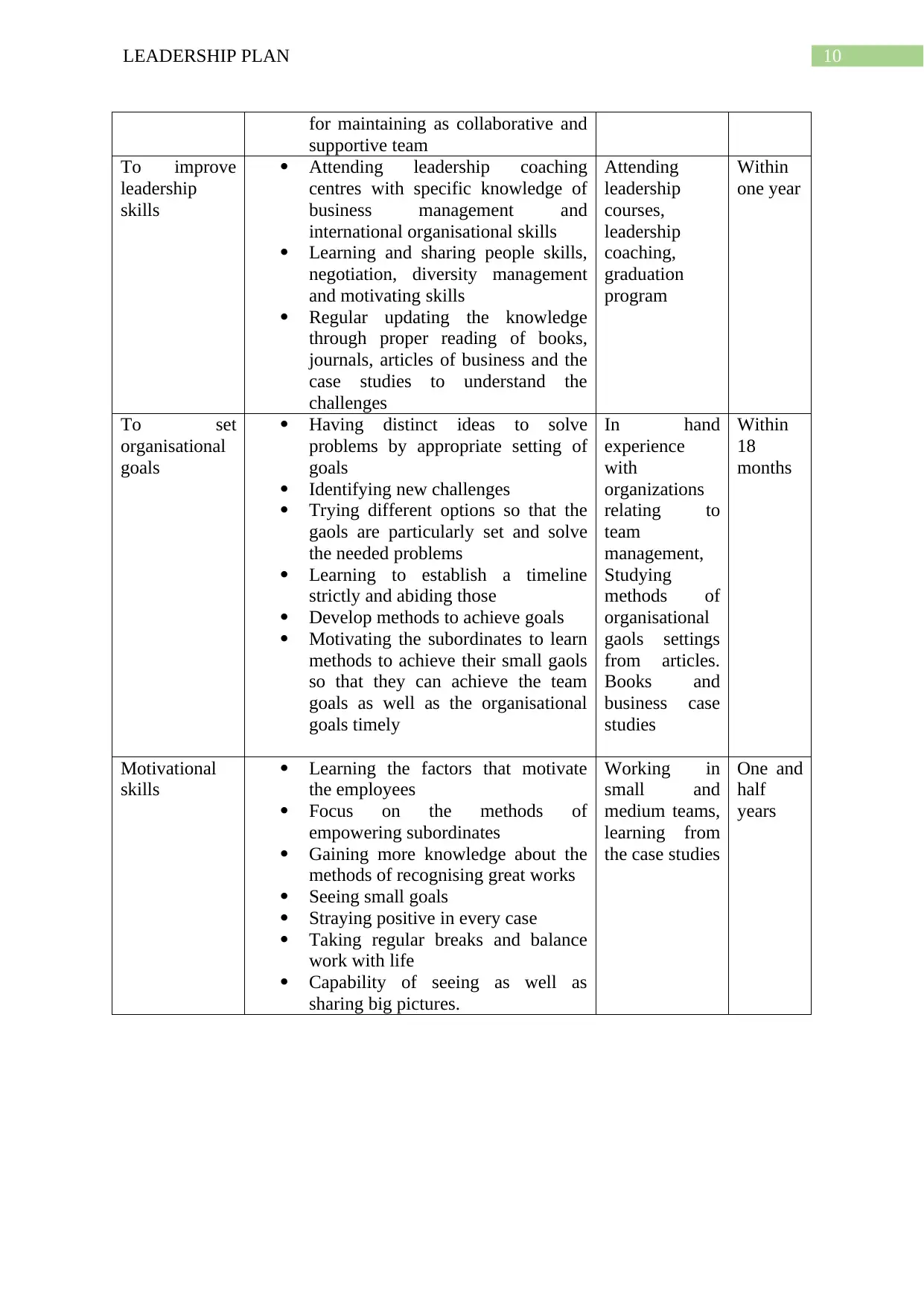
10LEADERSHIP PLAN
for maintaining as collaborative and
supportive team
To improve
leadership
skills
Attending leadership coaching
centres with specific knowledge of
business management and
international organisational skills
Learning and sharing people skills,
negotiation, diversity management
and motivating skills
Regular updating the knowledge
through proper reading of books,
journals, articles of business and the
case studies to understand the
challenges
Attending
leadership
courses,
leadership
coaching,
graduation
program
Within
one year
To set
organisational
goals
Having distinct ideas to solve
problems by appropriate setting of
goals
Identifying new challenges
Trying different options so that the
gaols are particularly set and solve
the needed problems
Learning to establish a timeline
strictly and abiding those
Develop methods to achieve goals
Motivating the subordinates to learn
methods to achieve their small gaols
so that they can achieve the team
goals as well as the organisational
goals timely
In hand
experience
with
organizations
relating to
team
management,
Studying
methods of
organisational
gaols settings
from articles.
Books and
business case
studies
Within
18
months
Motivational
skills
Learning the factors that motivate
the employees
Focus on the methods of
empowering subordinates
Gaining more knowledge about the
methods of recognising great works
Seeing small goals
Straying positive in every case
Taking regular breaks and balance
work with life
Capability of seeing as well as
sharing big pictures.
Working in
small and
medium teams,
learning from
the case studies
One and
half
years
for maintaining as collaborative and
supportive team
To improve
leadership
skills
Attending leadership coaching
centres with specific knowledge of
business management and
international organisational skills
Learning and sharing people skills,
negotiation, diversity management
and motivating skills
Regular updating the knowledge
through proper reading of books,
journals, articles of business and the
case studies to understand the
challenges
Attending
leadership
courses,
leadership
coaching,
graduation
program
Within
one year
To set
organisational
goals
Having distinct ideas to solve
problems by appropriate setting of
goals
Identifying new challenges
Trying different options so that the
gaols are particularly set and solve
the needed problems
Learning to establish a timeline
strictly and abiding those
Develop methods to achieve goals
Motivating the subordinates to learn
methods to achieve their small gaols
so that they can achieve the team
goals as well as the organisational
goals timely
In hand
experience
with
organizations
relating to
team
management,
Studying
methods of
organisational
gaols settings
from articles.
Books and
business case
studies
Within
18
months
Motivational
skills
Learning the factors that motivate
the employees
Focus on the methods of
empowering subordinates
Gaining more knowledge about the
methods of recognising great works
Seeing small goals
Straying positive in every case
Taking regular breaks and balance
work with life
Capability of seeing as well as
sharing big pictures.
Working in
small and
medium teams,
learning from
the case studies
One and
half
years
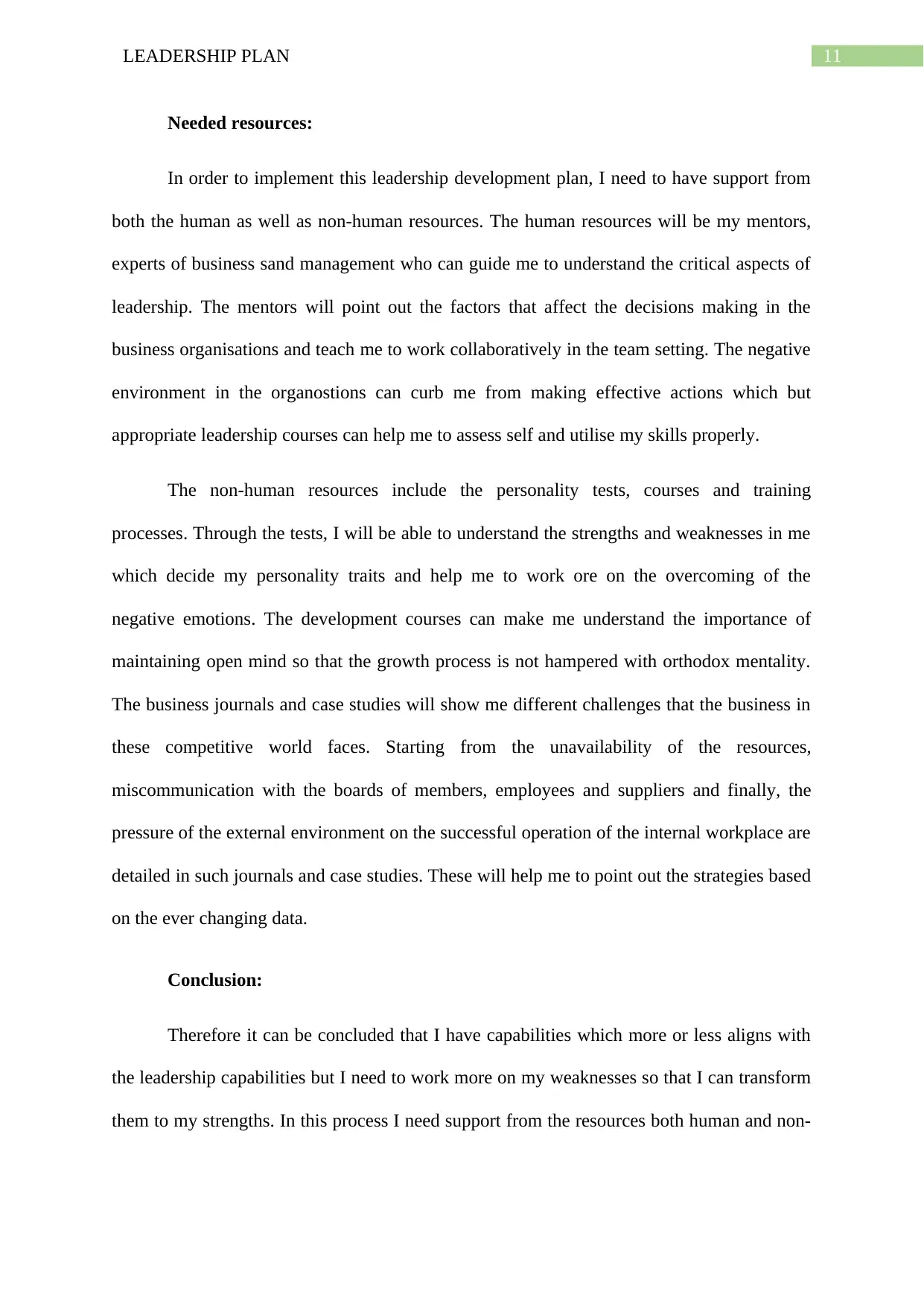
11LEADERSHIP PLAN
Needed resources:
In order to implement this leadership development plan, I need to have support from
both the human as well as non-human resources. The human resources will be my mentors,
experts of business sand management who can guide me to understand the critical aspects of
leadership. The mentors will point out the factors that affect the decisions making in the
business organisations and teach me to work collaboratively in the team setting. The negative
environment in the organostions can curb me from making effective actions which but
appropriate leadership courses can help me to assess self and utilise my skills properly.
The non-human resources include the personality tests, courses and training
processes. Through the tests, I will be able to understand the strengths and weaknesses in me
which decide my personality traits and help me to work ore on the overcoming of the
negative emotions. The development courses can make me understand the importance of
maintaining open mind so that the growth process is not hampered with orthodox mentality.
The business journals and case studies will show me different challenges that the business in
these competitive world faces. Starting from the unavailability of the resources,
miscommunication with the boards of members, employees and suppliers and finally, the
pressure of the external environment on the successful operation of the internal workplace are
detailed in such journals and case studies. These will help me to point out the strategies based
on the ever changing data.
Conclusion:
Therefore it can be concluded that I have capabilities which more or less aligns with
the leadership capabilities but I need to work more on my weaknesses so that I can transform
them to my strengths. In this process I need support from the resources both human and non-
Needed resources:
In order to implement this leadership development plan, I need to have support from
both the human as well as non-human resources. The human resources will be my mentors,
experts of business sand management who can guide me to understand the critical aspects of
leadership. The mentors will point out the factors that affect the decisions making in the
business organisations and teach me to work collaboratively in the team setting. The negative
environment in the organostions can curb me from making effective actions which but
appropriate leadership courses can help me to assess self and utilise my skills properly.
The non-human resources include the personality tests, courses and training
processes. Through the tests, I will be able to understand the strengths and weaknesses in me
which decide my personality traits and help me to work ore on the overcoming of the
negative emotions. The development courses can make me understand the importance of
maintaining open mind so that the growth process is not hampered with orthodox mentality.
The business journals and case studies will show me different challenges that the business in
these competitive world faces. Starting from the unavailability of the resources,
miscommunication with the boards of members, employees and suppliers and finally, the
pressure of the external environment on the successful operation of the internal workplace are
detailed in such journals and case studies. These will help me to point out the strategies based
on the ever changing data.
Conclusion:
Therefore it can be concluded that I have capabilities which more or less aligns with
the leadership capabilities but I need to work more on my weaknesses so that I can transform
them to my strengths. In this process I need support from the resources both human and non-
⊘ This is a preview!⊘
Do you want full access?
Subscribe today to unlock all pages.

Trusted by 1+ million students worldwide
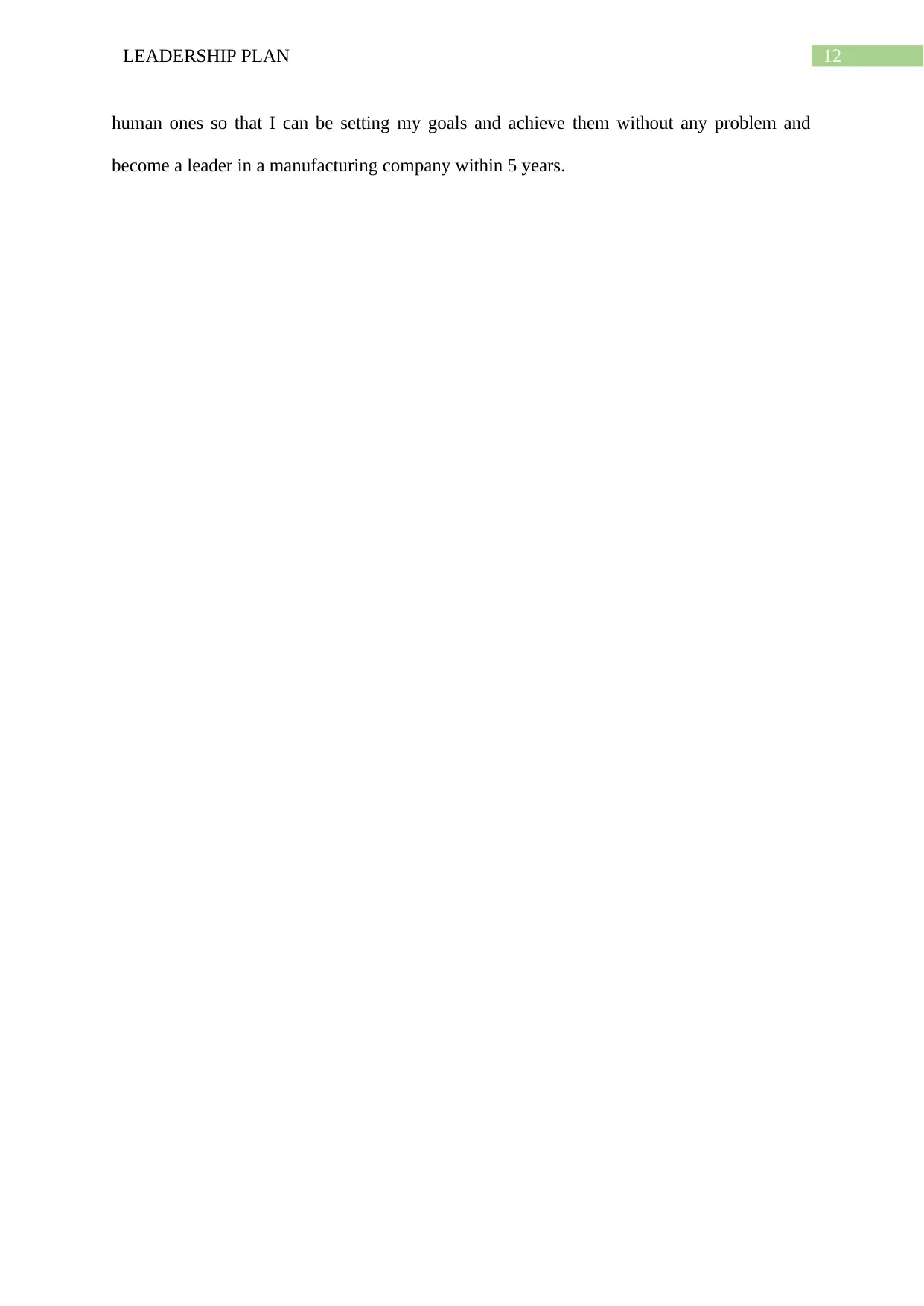
12LEADERSHIP PLAN
human ones so that I can be setting my goals and achieve them without any problem and
become a leader in a manufacturing company within 5 years.
human ones so that I can be setting my goals and achieve them without any problem and
become a leader in a manufacturing company within 5 years.
Paraphrase This Document
Need a fresh take? Get an instant paraphrase of this document with our AI Paraphraser
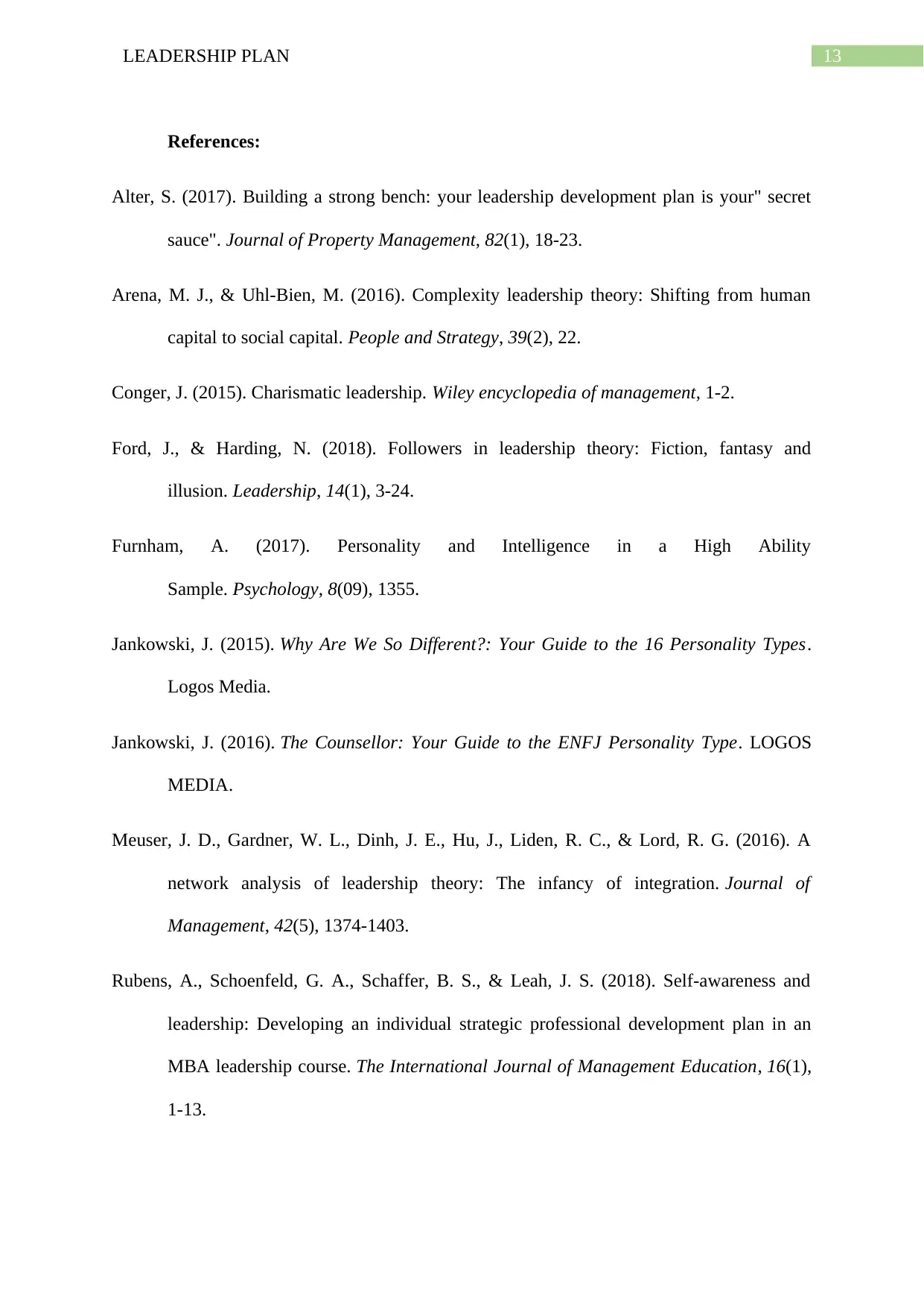
13LEADERSHIP PLAN
References:
Alter, S. (2017). Building a strong bench: your leadership development plan is your" secret
sauce". Journal of Property Management, 82(1), 18-23.
Arena, M. J., & Uhl-Bien, M. (2016). Complexity leadership theory: Shifting from human
capital to social capital. People and Strategy, 39(2), 22.
Conger, J. (2015). Charismatic leadership. Wiley encyclopedia of management, 1-2.
Ford, J., & Harding, N. (2018). Followers in leadership theory: Fiction, fantasy and
illusion. Leadership, 14(1), 3-24.
Furnham, A. (2017). Personality and Intelligence in a High Ability
Sample. Psychology, 8(09), 1355.
Jankowski, J. (2015). Why Are We So Different?: Your Guide to the 16 Personality Types.
Logos Media.
Jankowski, J. (2016). The Counsellor: Your Guide to the ENFJ Personality Type. LOGOS
MEDIA.
Meuser, J. D., Gardner, W. L., Dinh, J. E., Hu, J., Liden, R. C., & Lord, R. G. (2016). A
network analysis of leadership theory: The infancy of integration. Journal of
Management, 42(5), 1374-1403.
Rubens, A., Schoenfeld, G. A., Schaffer, B. S., & Leah, J. S. (2018). Self-awareness and
leadership: Developing an individual strategic professional development plan in an
MBA leadership course. The International Journal of Management Education, 16(1),
1-13.
References:
Alter, S. (2017). Building a strong bench: your leadership development plan is your" secret
sauce". Journal of Property Management, 82(1), 18-23.
Arena, M. J., & Uhl-Bien, M. (2016). Complexity leadership theory: Shifting from human
capital to social capital. People and Strategy, 39(2), 22.
Conger, J. (2015). Charismatic leadership. Wiley encyclopedia of management, 1-2.
Ford, J., & Harding, N. (2018). Followers in leadership theory: Fiction, fantasy and
illusion. Leadership, 14(1), 3-24.
Furnham, A. (2017). Personality and Intelligence in a High Ability
Sample. Psychology, 8(09), 1355.
Jankowski, J. (2015). Why Are We So Different?: Your Guide to the 16 Personality Types.
Logos Media.
Jankowski, J. (2016). The Counsellor: Your Guide to the ENFJ Personality Type. LOGOS
MEDIA.
Meuser, J. D., Gardner, W. L., Dinh, J. E., Hu, J., Liden, R. C., & Lord, R. G. (2016). A
network analysis of leadership theory: The infancy of integration. Journal of
Management, 42(5), 1374-1403.
Rubens, A., Schoenfeld, G. A., Schaffer, B. S., & Leah, J. S. (2018). Self-awareness and
leadership: Developing an individual strategic professional development plan in an
MBA leadership course. The International Journal of Management Education, 16(1),
1-13.
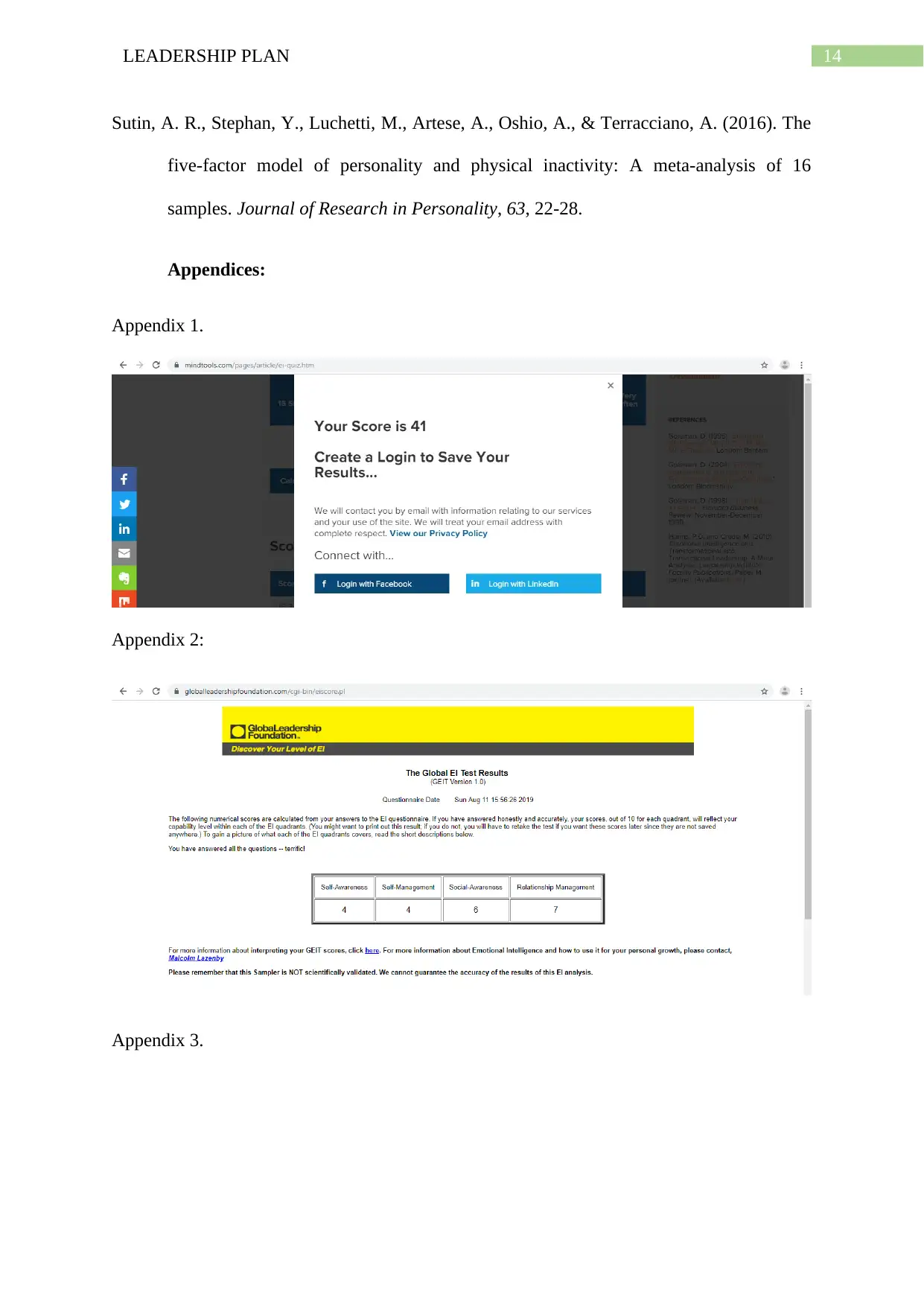
14LEADERSHIP PLAN
Sutin, A. R., Stephan, Y., Luchetti, M., Artese, A., Oshio, A., & Terracciano, A. (2016). The
five-factor model of personality and physical inactivity: A meta-analysis of 16
samples. Journal of Research in Personality, 63, 22-28.
Appendices:
Appendix 1.
Appendix 2:
Appendix 3.
Sutin, A. R., Stephan, Y., Luchetti, M., Artese, A., Oshio, A., & Terracciano, A. (2016). The
five-factor model of personality and physical inactivity: A meta-analysis of 16
samples. Journal of Research in Personality, 63, 22-28.
Appendices:
Appendix 1.
Appendix 2:
Appendix 3.
⊘ This is a preview!⊘
Do you want full access?
Subscribe today to unlock all pages.

Trusted by 1+ million students worldwide

15LEADERSHIP PLAN
1 out of 16
Related Documents
Your All-in-One AI-Powered Toolkit for Academic Success.
+13062052269
info@desklib.com
Available 24*7 on WhatsApp / Email
![[object Object]](/_next/static/media/star-bottom.7253800d.svg)
Unlock your academic potential
© 2024 | Zucol Services PVT LTD | All rights reserved.




